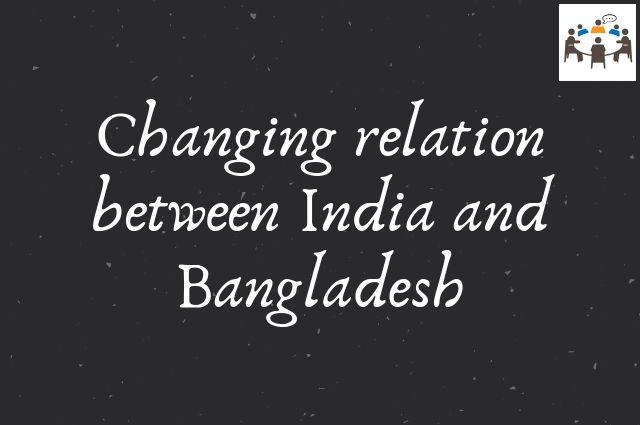History:
India and Bangladesh share common linguistic and cultural ties, interests in art and culture and common history till 1947. From 1947 to 1971, Bangladesh was known as East Pakistan. In 1971, with the help of India, East Pakistan succeeded in gaining independence from Pakistan and established itself as Bangladesh. From the mid 1970s, the relations went downhill as Bangladesh identified itself as an Islamic country and developed closer ties with the Islamic countries and participated in OIC. Both the countries developed different cold war alliances in1980s. However, post-1990, with the liberalization in South Asia the bilateral relations improved. Ganges Water Treaty was concluded in 1996, both the countries agreed to fight terrorism together and also are the largest trading partners in South Asia.
Developments in Relations over time:
- In 2011, both the countries signed a major accord ending a 4-decade long border dispute. The area is known as the Teen Bigha Corridor, and India has leased this area to Bangladesh so that it (Bangladesh) can access its Dahagram-Angarpota enclaves.
- From 2013, India started exporting 500 MW of electricity on a daily basis. And India will continue to do so for 35 years.
- India’s NTPC is setting up a 1320 MW coal-fired electricity plant in Rampal, Bangladesh as a joint venture with Bangladesh Power Development Board.
- In 2014, Sushma Swaraj (then Minister of External Affairs) during her first official overseas visit concluded various agreements:
-
- Easing of Visa regime to provide 5-year multiple entry visas to minors below 13 and elderly above 65.
- Proposal of a Special Economic Zone in Bangladesh.
- Additional 100MW power to Bangladesh from Tripura.
- Increase in frequency of Miatree Express.
- Bus services between Dhaka and Guwahati and Shillong.
- Bangladesh allowed India to ferry food grains to the northeast using its territory. (In 2012 Bangladesh allowed India’s ONGC to ferry heavy machinery to Tripura through it.)
- In 2015, India has extended 2 million dollars line of credit and pledged investment of 5 million dollars. Also signed 22 agreements including countering terrorism, maritime cooperation, curbing human trafficking and fake currency.
- Reliance and Adani have started setting up power plants in Bangladesh.
- In 2018, the leaders of both the countries inaugurated the 130 km long Bangladesh-India Friendship pipeline to supply 4 lakh metric tonnes of diesel to Bangladesh.
- In September 2018, Bangladesh approved the draft of a proposed agreement with India to allow India to use the Chittagong and Mongla seaports for transporting goods to and from its land-locked north-eastern states.
- Bangladesh and India signed two defence agreements in 2017, according to which the militaries of both the country will conduct joint exercise and training. And India will help Bangladesh in setting up of manufacturing and service platforms of defence equipment. India has also extended a 500-million-dollar line of credit to Bangladesh for buying defence equipment.
- Apart from providing electric power, India will help Bangladesh in setting up Nuclear plants for civil purposes.
- For infrastructure development, India has given soft loans of more than 2 billion dollars.
- India provides scholarships to meritorious Bangladeshi students.
- In 2018 trade was estimated to be of about 10 billion dollars, India having the trade surplus. India also provides duty-free import to Bangladeshi goods. Both the countries have agreed to use each other’s ports to send goods to third country.
Areas of Contentions between India and Bangladesh:
- Bangladesh’s closeness with China: Bangladesh considers China as its all-weather friend. China invests hugely in Bangladesh, helps Bangladesh in infrastructural development projects and delivers timely (an area where India is struggling). The Chinese investments are coherent with the goals of both countries. Bangladesh wants to be a developed country by 2040 so it is using the Chinese resources to the fullest. And China wants to be a major influential power in this region. China also has been able to successfully tap the Bangladeshi markets. And it has a huge trade surplus with Bangladesh.
China has wisely capitalised its generosity and gained a political advantage by convincing Bangladesh for BRI and backing its position for observer status in SAARC.
China is the only country to have defence agreement with Bangladesh. It trains their officers, conducts various military exercises and is the largest supplier of defence equipment Bangladesh. Be it rifles, aircraft, missiles or submarines.
- India’s silence on atrocities by Myanmar on Rohingya Muslims: Bangladesh wants India to build pressure on Myanmar to take back its refugees and promise a humane treatment with them. Bangladesh, already a densely populated country has been flooded with Rohingya migrants. It is getting difficult for Bangladesh to manage them.
- Prolonged Teesta River Dispute.
Conclusion:
Though analysts in Bangladesh have repeatedly said that India should not be worried about Bangladesh’s relations with China, as it wants to have good relations with both the countries. But India should be wary about it. The new government’s Look East policy is a positive step ahead. India should make meeting deadlines of the development projects a priority as we have been losing the trust of our neighbours because of failure to meet deadlines, an area where China beats us. The relations have been cordial between both the countries and India should work extensively on strengthening the ties with neighbours as the first step to be influential globally is to be strong in your own backyard.
Your Turn…
What is your take on this topic? Express your thoughts through the comment section below. And subscribe to our blog to read answers to trending GD topics.
Copyright @ Group Discussion Ideas.

